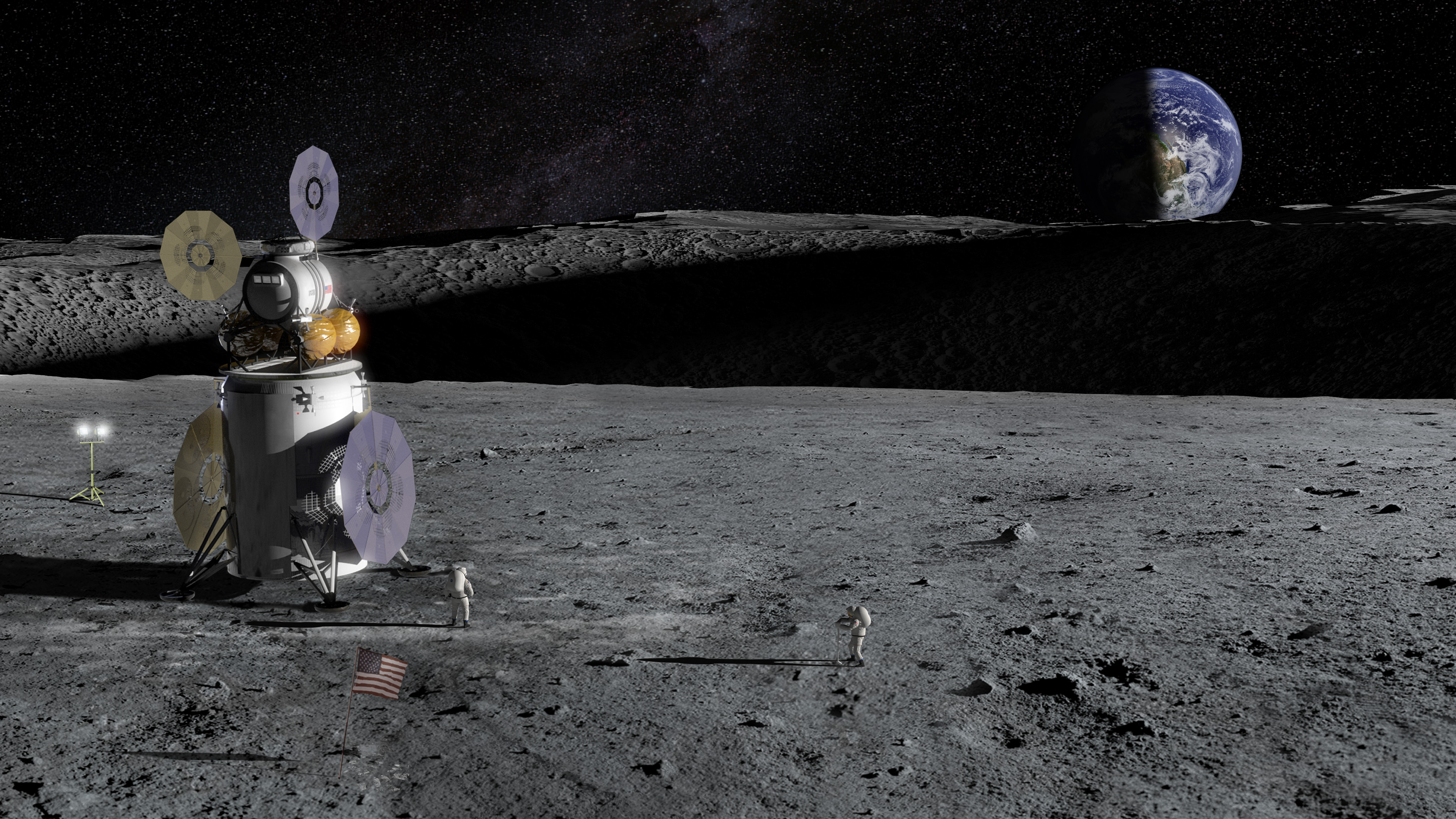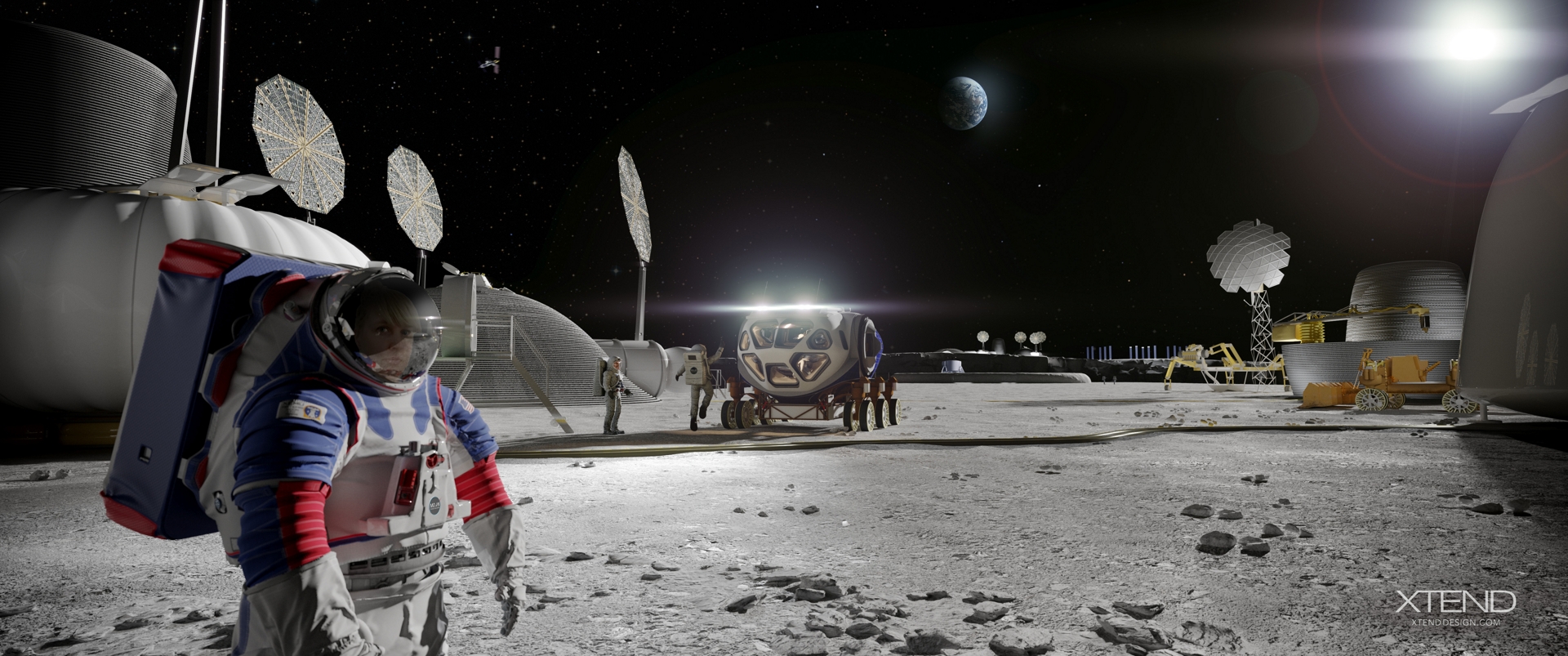Cold as (lunar) ice: Protecting the moon's polar regions from contamination
Exploration should be done thoughtfully, scientists say.

Permanently shadowed regions at the moon's poles have a story to tell. Sun-shy polar ice patches could not only yield an account of lunar history but also offer astrobiological clues regarding the origin of life.
The permanently shadowed floors of polar craters are generally between 3.4 to 3.9 billion years old, based on cratering statistics.
NASA's Artemis program calls for landing the first woman and next man on the moon by 2024. The agency also aims to establish sustainable exploration there by the end of the decade, a project that may include a base camp near Shackleton Crater at the moon's south pole.
Such ambitious exploration efforts would likely rely, at least in part, on water ice mined from polar craters. And that raises a question: Can humanity utilize this precious resource without compromising the poles' scientific potential?
Related: NASA unveils plan for Artemis 'base camp' on the moon beyond 2024
Interim directive
Last month, NASA rolled out an interim directive titled "Planetary Protection Categorization for Robotic and Crewed Missions to the Earth's Moon."
The document defines NASA's implementation of obligations to avoid harmful contamination under the United Nations' Outer Space Treaty, which came into effect in 1967.
Get the Space.com Newsletter
Breaking space news, the latest updates on rocket launches, skywatching events and more!
The new directive specifically addresses the control of terrestrial biological contamination associated with space vehicles intended to land, orbit, fly by or otherwise encounter Earth's nearest celestial neighbor.
The document separates the lunar surface into two categories. Most of the moon is defined as "Category I," which requires minimal planetary protection measures. But permanently shadowed polar areas that harbor water ice are classified as the slightly more restrictive "Category II," as are the Apollo landing sites and other historical spots.
The relevant permanently shadowed regions "have scientific value in the study of the history of the solar system and [are] of significant interest relative to the process of chemical evolution, as well as potential value for In-Situ Resource Utilization (ISRU)," the directive states.
The directive does not apply to other countries or private sector firms if their missions do not involve NASA. If ISRU becomes a reality on the moon and polar craters are indeed mined for their water ice, could a scientific bonanza be wiped out?
Larger issue
Policy and directive decision-making concerning lunar protection "has raised the larger issue of how to balance development and science on the moon," said Paul Lucey, a planetary scientist at the Hawaii Institute of Geophysics and Planetology at the University of Hawaii at Manoa.
"Some parts of the moon are very fragile, especially the lunar atmosphere and the coldest parts of the lunar poles," Lucey told Space.com. "Extensive human activity may permanently alter these environments, leading to a loss of the science they can provide."
That science is potentially substantial, researchers said.
"Personally, I believe that the moon provides an interesting target for astrobiology, in that it can potentially help scientists fill in the gaps about what the conditions on the primordial Earth may have been like, and perhaps insights into the organic inventory that may have been available," said Chris Bennett, an assistant professor in the Department of Physics/Planetary Science at the University of Central Florida in Orlando.
Back-of-the-envelope calculations suggest that substantial amounts of amino acids could have been brought to Earth by carbonaceous chondritic meteorites, Bennett told Space.com.
"However, geological processes and even life itself has literally eroded away the surface of the Earth during the first billion years, along with it the possibility of determining what the conditions were like back then," Bennett said.
The same is not true of the moon. Earth's nearest neighbor harbors a record of the bombardment experienced during the solar system's early days, preserved in the rocks brought back during Apollo and the former Soviet Union's Luna program. And many of these returned moon samples are older than any rocks found on Earth.
"There is evidence of the exogenous delivery of organics — i.e., from comets, meteorites and their associated interplanetary dust particles — still present on the moon today," said Bennett. "Yet, this work emphasizes the need to get back to the moon and collect new samples for analysis."
Related: The search for water on the moon in pictures

Polar microenvironment
Could rocket exhaust gases contaminate permanently shadowed lunar craters?
Research on this prospect is being pursued by Parvathy Prem, a staff scientist in the Planetary Exploration Group at the Johns Hopkins University Applied Physics Laboratory in Laurel, Maryland.
"I think my main takeaway from the work I've been doing is that the redistribution of exhaust gases could be the most widespread and longest-lived modification of the lunar environment by a spacecraft," Prem said. "Contamination of permanently shadowed regions could potentially be minimized by planning trajectories and propellant use accordingly."
Prem said that, because of the sensitivity of gas-surface interactions to surface temperature, it appears that there may be a tradeoff between heavy contamination of a limited area versus light contamination of a wider area.
"So, [there's] no clear-cut distance at which exhaust would not influence a permanently shadowed region," Prem said. "It really depends on the landing trajectory, the propellant used and also some of the specifics of how water and other volatiles interact with the lunar surface, which we don't yet know for certain."
Taking a big-picture view, Prem thinks the main thing to keep in mind is that the lunar polar microenvironment is unique in many ways.
"When we visit it, we will inevitably alter it, temporarily or permanently. I would say that understanding and planning for the impact of spacecraft systems on the lunar environment is critical to carrying out meaningful and responsible science," Prem concluded.
Leonard David is the author of the book, "Moon Rush: The New Space Race," which was published by National Geographic in May 2019. A longtime writer for Space.com, David has been reporting on the space industry for more than five decades. Follow us on Twitter @Spacedotcom and on Facebook.
Join our Space Forums to keep talking space on the latest missions, night sky and more! And if you have a news tip, correction or comment, let us know at: community@space.com.

Leonard David is an award-winning space journalist who has been reporting on space activities for more than 50 years. Currently writing as Space.com's Space Insider Columnist among his other projects, Leonard has authored numerous books on space exploration, Mars missions and more, with his latest being "Moon Rush: The New Space Race" published in 2019 by National Geographic. He also wrote "Mars: Our Future on the Red Planet" released in 2016 by National Geographic. Leonard has served as a correspondent for SpaceNews, Scientific American and Aerospace America for the AIAA. He has received many awards, including the first Ordway Award for Sustained Excellence in Spaceflight History in 2015 at the AAS Wernher von Braun Memorial Symposium. You can find out Leonard's latest project at his website and on Twitter.
-
Dr Bugsy Artemis should choose the best qualified people. I do not care for qualification criteria based on gender, color, religion, political affiliation, etc.Reply -
egribble We can sit on earth and not expand out into space. That way we protect the science on lifeless worlds. Probably billions of worlds just like the moon throughout the Universe, but let's just sit at home till we become extinct. Alternatively we can ensure the long term survival of life by expanding outward and utilizing the resources of space. This planetary protection stuff is stupidity.Reply -
FB36 IMHO there is no need to try to mine ice on the moon! (& it would be incredibly hard to do anyway!)Reply
There is already space tech NASA uses that recycles water!
How about recycling air?
NASA is already trying to test a tech that can turn CO2 in air back to O2:
https://mars.nasa.gov/mars2020/spacecraft/instruments/moxie/
(Carbon dust/powder (after recycling CO2) just can be stored as trash or dumped outside!)
(So a moon base would really only require food for people (when right tech is used); NOT ice/water!) -
Gustavo Porto de Mello Reply
You are quite right. Not moving out and expanding is sheer long term suicide of the race. But alas, this idea must be sold politically. So let us sharpen up our arguments! Some scientific protection is warranted, but the Moon is needed as a source of resources, advanced outpost, and space base for expanding throughout the Solar System. Some parts of it may be closed off for occupation as reservations or such. Rocket exhaust will have to be coped with, however - so sorry.egribble said:We can sit on earth and not expand out into space. That way we protect the science on lifeless worlds. Probably billions of worlds just like the moon throughout the Universe, but let's just sit at home till we become extinct. Alternatively we can ensure the long term survival of life by expanding outward and utilizing the resources of space. This planetary protection stuff is stupidity.









